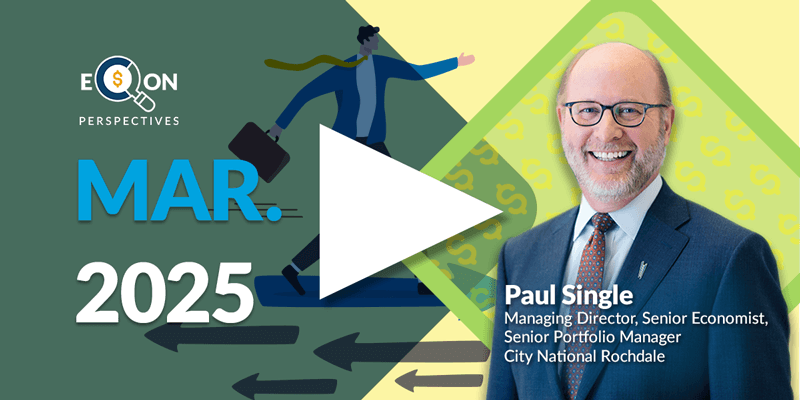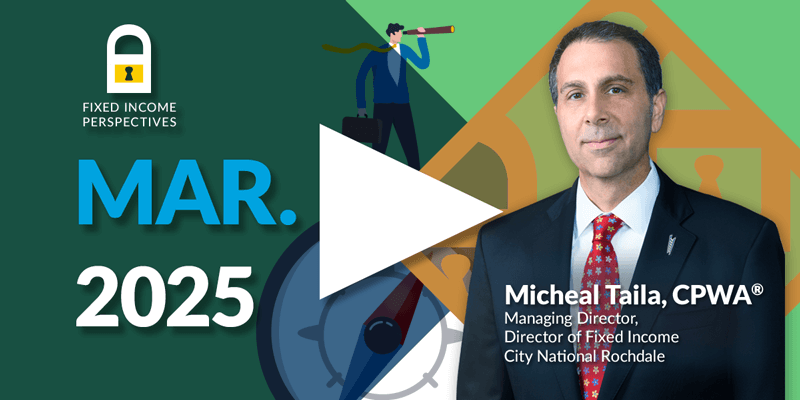-
Market Perspectives
A “Tariff-ying” Start to the 2nd Quarter
April 2025
- Filename
- Market Perspectives APRIL 2025.pdf
- Format
- application/pdf
TRANSCRIPT
April is the cruelest month. Now, is that the opening line to a T.S. Eliot poem or a recent Wall Street Journal headline?
After a bumpy and negative first quarter for U.S. stocks, April upped the ante with some “tariffying” volatility. Apologies. Hopefully, that's the last bad pun for the year. After the Liberation Day tariff announcements, the S&P 500 fell over 12% over the following four trading days, unsettling even seasoned investors. Shortly thereafter, the administration walked back its hard line stance providing relief for both the bond and stock markets.
For a detailed breakdown of the tariff situation and what it means for your portfolio, check out our latest tariff update article. > TRUMP TRADE TARIFF UPDATE
The S&P 500 jumped almost 10% in one day, the third largest move up in the S&P 500 post- World War II. We haven't seen volatility on this level since March of 2020, which, by the way, had some of the biggest swings in the S&P 500, up and down in the past 100 years. Some of the recent changes in messaging from the administration include a 90-day pause on the announced tariffs, as well as some exemptions on electronics.
So, just maybe that $3,000 dollar iPhone isn't happening anytime soon. What we can't escape is the high-level uncertainty, which makes the current environment challenging for investors and business owners to navigate. While it is tempting for even steadfast investors to reduce risk during tumultuous market swings, it is advisable to avoid the temptation.
The Impact of Timing on Equity Returns
Value of $1M Invested in the S&P 500 (Jan. 2003 - March 2025)

Data current as of April 3, 2025.
Sources: JP Morgan, S&P 500 index total returns from January 1, 2003 to March 25, 2025
Information is subject to change and is not a guarantee of future results.
Chart 1, 1:43— History tells us markets can move and burst and missing the big up days materially hurts returns over time. This chart is a good reminder of that. Note that some of the biggest up days occur during volatile periods. The bar chart shows how costly it is to miss the best 10, 20, 30, and so on days versus staying invested through the volatile periods.
In addition, those who do move to reduce risk usually do so too late to receive any material marginal benefit. Tariffs have introduced a new structural risk clouding the near-term outlook. Businesses and consumers are adjusting, and market pricing is likely to remain reactive to shifting trade signals.
So, what are we focusing on? Well, one, 2025 earnings estimates will come down. Earnings season started with some well-known financials beating estimates, but the real risk to earnings is a demand shock resulting in lower activity. Early indications and the potential for resolutions keep hope alive that prices can adjust without major structural inflationary pressure.
That said, we estimate potential tariff drag on earnings could reduce earnings growth 4 to 6% from our original 2025 growth estimate of 10 to 14%.
Two, the economy can withstand the tariff increases to a point. Strategists are all over the map with their calls. A notable example, Goldman Sachs came out with a recessionary call and then rescinded it within an hour. Non-farm payrolls, claims, CPI, and wages all signal a strong economic starting point. That said, we have revised our GDP forecast downward by 1 to 1.5%.
Three, continued belief in other elements of policy that may help cushion the blow of tariffs, specifically deregulation and tax policy.
House Republicans approved their budget framework, satisfying GOP holdouts aiming towards steeper spending cuts. Other parts of the agenda will continue to advance. And while it looks today as if the tariff situation will never go away, it will reach an equilibrium once the outcome of negotiations is known. Our read is the president is conciliatory and open to deals.
Finally, four, the Fed's mandate has become more difficult. And it is likely the Fed remains on the sidelines because of the inflationary impact, and we don't agree that the Fed will be forced to cut rates more than our initial expectations. Fed funds’ futures priced as many as five cuts, but now are pricing in three cuts by the end of the year. The Fed won't cut until unemployment rises or there is a clear view on inflation. So don't always trust the futures.
To sum up, uncertainty is likely to remain high. Markets are reacting to concerns of economic slowdown as well as the risk of heightened inflationary pressures.
City National Rochdale portfolios are positioned appropriately and are so far holding up relatively well year to date versus the S&P 500. We maintain our modest overweight to U.S. equities focused on quality and valuation. Dislocation presents opportunity, but market swings demand discipline.
Our outlook remains constructive but less predictable. The long-term opportunity set remains, but the playbook is shifting. Flexibility, fundamentals, and a clear-eyed view of evolving policy risk will be key. And as always, we're keeping a close watch for opportunities as well as ways to effectively manage risk.
Important Information
The views expressed represent the opinions of City National Rochdale, LLC (CNR) which are subject to change and are not intended as a forecast or guarantee of future results. Stated information is provided for informational purposes only, and should not be perceived as personalized investment, financial, legal or tax advice or a recommendation for any security. It is derived from proprietary and non-proprietary sources which have not been independently verified for accuracy or completeness.
While CNR believes the information to be accurate and reliable, we do not claim or have responsibility for its completeness, accuracy, or reliability. Statements of future expectations, estimates, projections, and other forward-looking statements are based on available information and management's view as of the time of these statements. Accordingly, such statements are inherently speculative as they are based on assumptions which may involve known and unknown risks and uncertainties. Actual results, performance or events may differ materially from those expressed or implied in such statements.
Past performance or performance based upon assumptions is no guarantee of future results.
All investing is subject to risk, including the possible loss of the money you invest. As with any investment strategy, there is no guarantee that investment objectives will be met and investors may lose money. Diversification does not ensure a profit or protect against a loss in a declining market.
Equity investing strategies & products. There are inherent risks with equity investing. These risks include, but are not limited to stock market, manager or investment style. Stock markets tend to move in cycles, with periods of rising prices and periods of falling prices.
Fixed Income investing strategies & products. There are inherent risks with fixed income investing. These risks include, but are not limited to, interest rate, call, credit, market, inflation, government policy, liquidity or junk bond risks. When interest rates rise, bond prices fall. This risk is heightened with investments in longer-duration fixed income securities and during periods when prevailing interest rates are low or negative.
City National Rochdale, LLC is an SEC-registered investment adviser and wholly-owned subsidiary of City National Bank. Registration as an investment adviser does not imply any level of skill or expertise. City National Bank is a subsidiary of the Royal Bank of Canada.
© 2025 City National Rochdale, LLC. All rights reserved.
Index Definitions
The Standard and Poor’s 500 Index (S&P 500) is a market capitalization-weighted index of 500 common stocks chosen for market size, liquidity, and industry group representation to represent U.S. equity performance.
Stay Informed.
Get our Insights delivered straight to your inbox.
Put our insights to work for you.
If you have a client with more than $1 million in investable assets and want to find out about the benefits of our intelligently personalized portfolio management, speak with an investment consultant near you today.
If you’re a high-net-worth client who's interested in adding an experienced investment manager to your financial team, learn more about working with us here.



